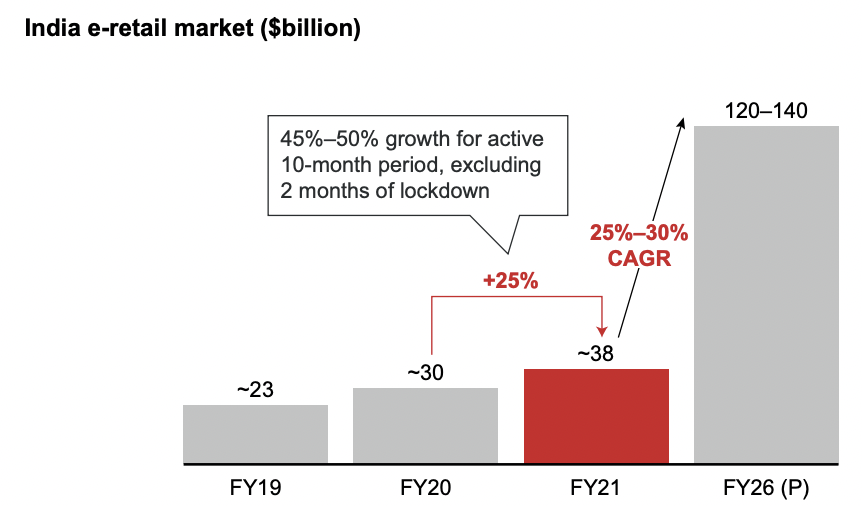The Indian e-commerce market grew by 25% to reach USD 38 billion in the financial year ending March 2021, even as the overall retail market shrunk 5% to USD 810 billion due to sustained lockdowns amid the COVID-19 pandemic, according to a new report by consultancy firm Bain & Co and Walmart-owned Flipkart.
The surge in e-retail came on the back of rapid, massive digital adoption in the country due to the healthcare crisis. Since the pandemic hit India in March 2020, 30–35 million new customers began transacting online, taking the total online shopper base to 140 million by the end of FY 2021, the third-largest globally, behind China and the US.
Still, less than one-fourth of India’s internet user base of 625–675 million is shopping online, which means the market remains “massively untapped.”
“The pandemic was a watershed moment for India’s e-retail market, driving a 12-month acceleration in e-retail penetration, which was at 4.6% by the end of FY 2021,” said researchers at Bain & Co. “This COVID-19 induced inflection in e-retail is a global phenomenon driven by an enhanced consumer need for safety and convenience, especially during elongated stay-at-home periods.”

Despite the second wave of COVID-19 that ravaged India in April and May this year, the e-commerce industry in the country is projected to surge by 25–30% to USD 47.5 billion by the end of the current financial year in March 2022.
Moreover, researchers at Bain & Co. expect the Indian e-retail market to continue to grow at 25–30% annually over the next five years to reach USD 120–140 billion by FY 2026. According to them, much of this growth is driven by non-metro markets.
“Small-town India will fuel this growth, accounting for four out of every five new shoppers. During the pandemic, reverse migration from metro cities further accelerated growth in smaller towns,” the report noted.
For instance, the growth rate of the gross merchandise value (total monetary value of products sold online) in lower-tier cities was 2.5–3x that of metro and tier 1 cities in 2020. Similarly, 80% of the new customers who came online to shop last year belonged to smaller Indian towns, the report found.
“In addition to small towns, women and older shoppers have gained prominence in the online shopper base over the last year, and this trend is expected to continue,” the researchers added.

The role of voice, vernacular, and social media in online shopping is also expanding, the report noted.
“Voice and vernacular are vital to attracting the next generation of online shoppers—one in 10 users have tried voice search, and one in three new users use a vernacular platform interface,” it said. “Influencers and social media channels are also increasingly nudging consumers to shop online—in 2020, 40% of online shoppers made at least one purchase through social media channels like Facebook, Instagram, and WhatsApp.”
Aside from voice-search and vernacular platforms, video commerce, social commerce, and direct-to-consumer (D2C) brands are among the major trends shaping the future of online shopping.
Video content creators are looking to monetize their following, which is likely to drive an uptick in video commerce, the report said, adding that local livestreaming commerce start-ups such as Bulbul and Simsim have seen 9–10x growth in user base over the last year. Meanwhile, social commerce is expected to increase from USD 1.5–2 billion in FY 2020 to USD 16–20 billion in FY 2025, growing at 55%–60% CAGR.
D2C brands have also nearly doubled over the last two years—from 40,000 in 2018 to about 80,000 in 2020—with the pandemic further accelerating this trend, the report observed. The number of D2C brands in the country is expected to reach 200,000–250,000 by 2025.
